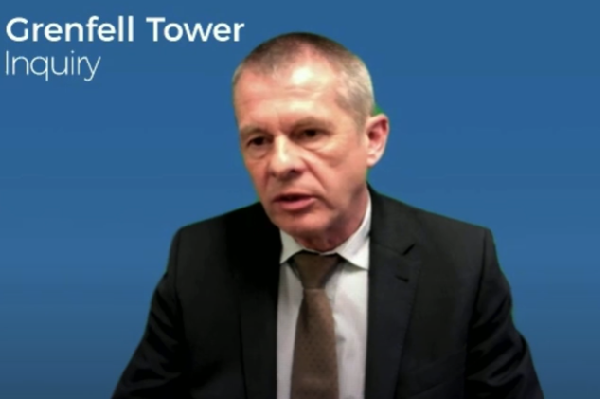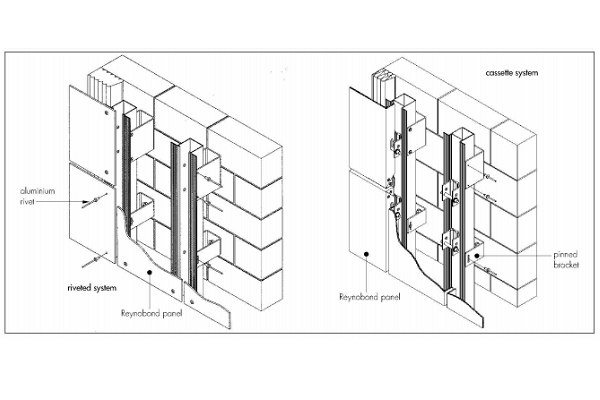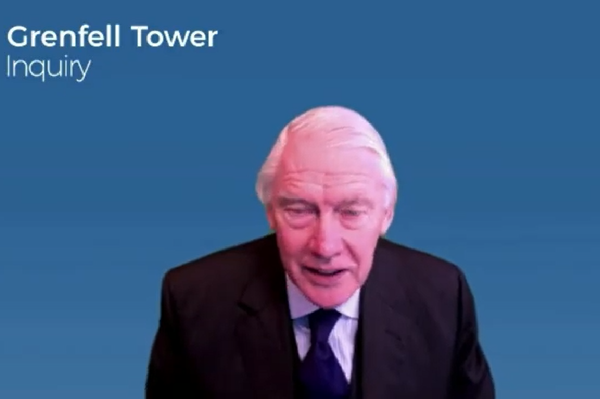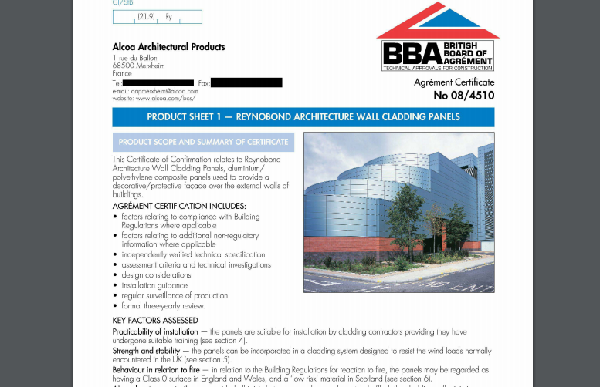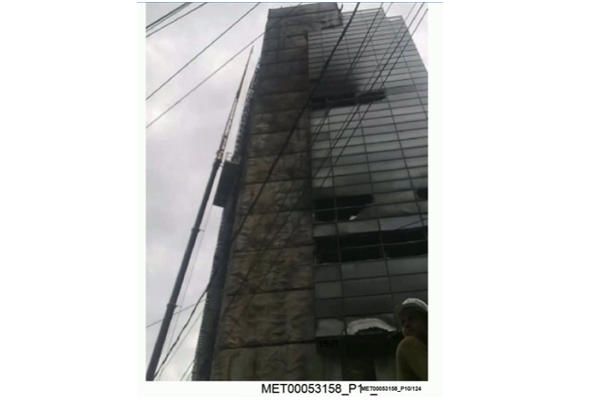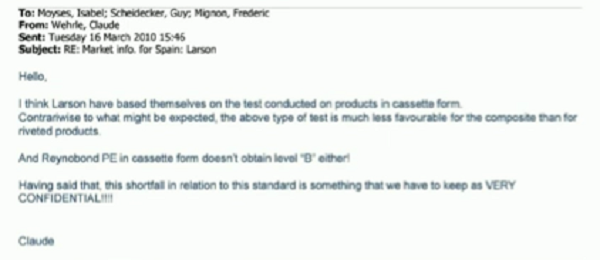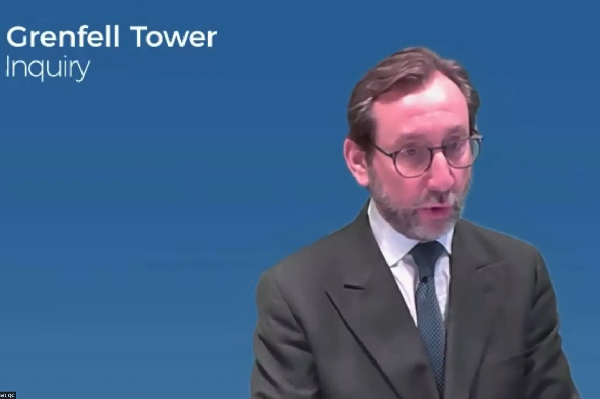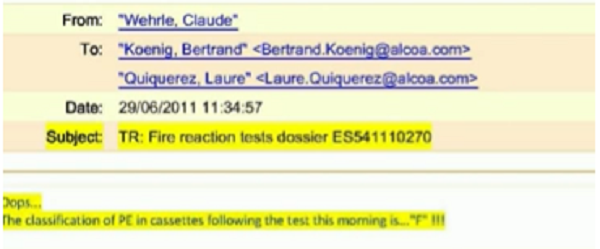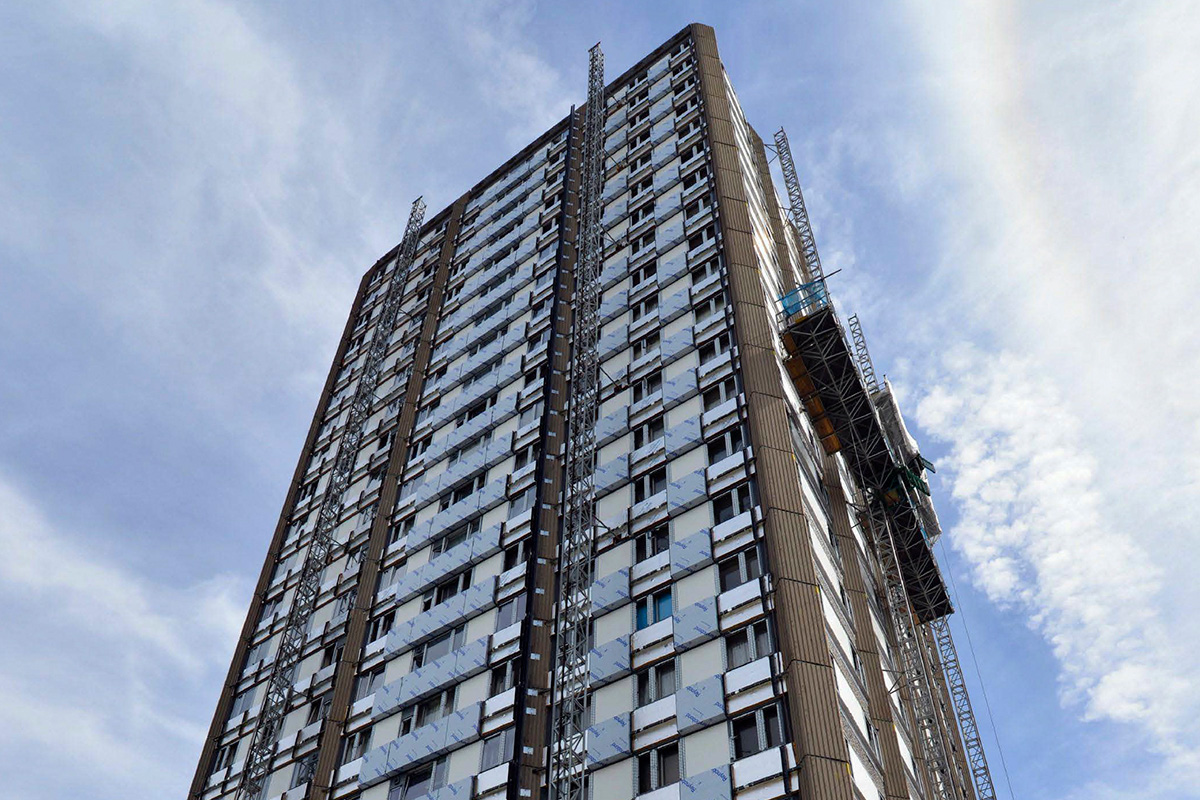Grenfell Tower Inquiry diary week 24: ‘Do you accept that Test 5B was Arconic’s deadly secret?’
The president of the firm that made and sold the cladding panels installed on Grenfell Tower was asked to account for the apparent concealment of “disastrous” fire tests on the product this week. Peter Apps reports
In order to properly explain the shocking evidence put before the Grenfell Tower Inquiry this week, it is necessary to begin with a few explanations.
The first is precisely who we were hearing from. The primary witness this week was Claude Schmidt, who has been president of AAP SAS since 2009.
AAP SAS is the French arm of the multinational American-based aluminium company Arconic. It is the company which made and sold the product that is at the heart of this inquiry: the Reynobond 55 PE panels, aluminium sheets bonded together with highly combustible polyethylene.
These were the panels on the outside of Grenfell Tower and have been identified as the “primary cause” of the rapid fire spread up its walls.
A critical fact to understand for this week’s evidence is that there were two ways these panels could be attached to the walls of a building: riveted (where they were bolted to the walls) or cassette (where they bent and hung on rails), as shown in the diagram below.
As we will see, this made a substantial difference to their fire performance, with the cassette system burning 10 times more fiercely. This cassette form is the way the panels were fitted to Grenfell Tower.
Finally, it is important to know that at the time the tower was refurbished, English building guidance set two potential fire safety standards which cladding panels used on a high rises could meet: European Class B or a national standard specific to England and Wales called Class 0. This latter class was weaker and easier to obtain.
With all of that held in mind, let us begin the story in November 2004.
“Do you accept that the cassettes performed spectacularly worse than the rivet-fix?”
In late 2004, new pan-European standards for fire performance had recently been introduced and Arconic knew details of how its products performed against these standards would soon be requested by its clients across Europe.
It therefore commissioned two tests at French national testing facility CSTB for its Reynobond 55 PE panels, one for the riveted and one for the cassette system. These tests were carried out in November 2004 and the reports issued in January 2005.
What they showed was startling. While the riveted system obtained a B grading, the cassette system performed disastrously. It burned 10 times more quickly than the rivet system, let off seven times as much heat and three times as much smoke. The test – referred to as Test 5B – was halted after 850 seconds and the result was so poor that no grade could be given.
“The results are not usable but give an idea of the fire behaviour of the product,” the CSTB report said.
“Do you accept that the cassettes, according to this Test 5B, performed spectacularly worse than the rivet-fix?” asked counsel to the inquiry Richard Millett QC.
“Yes,” responded Mr Schmidt (pictured above), speaking through a translator.
“One possible view is that it was irrational and irresponsible not to carry out further tests”
This confounded the expectations of Arconic. It expected the rivet panel to perform worse – given that its edges exposed the petrol-like polyethylene to the flames.
But Arconic, according to the witness statement of technical manager Claude Wehrle, did not take this result seriously. “No one really understood it,” he said. “The company had no reason to suspect this was anything other than the rogue result of a standard classification test.”
The company commissioned no further testing to confirm or dispute this and Mr Schmidt accepted when questioned that its view was “no more than untested assumption”.
“One possible view of the way that Arconic responded to that test we’re discussing is that it was irrational and irresponsible not to carry out further tests,” said inquiry chair Sir Martin Moore-Bick (pictured above). “What would you say about that?”
“Yes, as I said, I think that extra tests should have been carried out,” said Mr Schmidt.
But with the test dismissed as a rogue result (‘aberrant’ in French), no such testing was done and no information about the extreme fire risk of using it was disseminated to the market. The product was simply advertised as Class B, based on the successful test of the rivet system.
“Do you accept that Test 5B was Arconic’s deadly secret?” asked Mr Millett. Mr Schmidt disagreed, saying “there are many things that we do use every day which do give rise to certain risks”.
“Do you accept, as the voice of Arconic, that not providing test 5B to the BBA was a deliberate concealment of the true position?”
In 2006 Arconic sought a certificate from the British Board of Agrément (BBA) for its Reynobond cladding panels. In his witness statement, Claude Wehrle said this certificate was “largely obtained for marketing purposes”.
The BBA is a respected certification body which provides confirmation to UK construction professionals that a particular product meets the standards to which it is advertised.
For its product to be used on high rises in England and Wales, Arconic needed the certificate to confirm that it had a Class 0 rating, or a Euroclass B rating. It did both.
In order to obtain a ‘Class 0’ the firm supplied test data from 2003. But this, as the BBA could see, was carried out on a more fire retardant version of the product, which contained far less polyethylene. The certificate covered both varieties of panel.
But the certificate (pictured above) also said the panels had “achieved a classification” of European Class B. This was based wholly on the test on the rivet system. Arconic never told the British Board of Agrément (BBA) about the catastrophic failure when the panel was bent into cassettes.
This was despite a clause in the contract which required Arconic to provide “all test data” to the BBA, and a diagram in the certificate showed both rivet and cassette fixes.
“Do you accept, as the voice of Arconic, that not providing Test 5B to the BBA was a deliberate concealment of what Arconic knew to be the true position, namely that the cassette variant of Reynobond 55 PE performed disastrously in a fire?” asked Mr Millett.
“No. When you say deliberate, that’s too much,” said Mr Schmidt, explaining that the test was never asked about during audits by the BBA.
“Do you accept that in presenting the rivet Test 5A only to the BBA as representative of the fire performance of Reynobond 55 PE, Arconic was telling the BBA a misleading half truth?” asked Mr Millett.
“Yes, you can see it like that,” said Mr Schmidt.
The BBA certificate would later be relied on by the team refurbishing Grenfell Tower.
“This shortfall in relation to this standard is something we have to keep VERY CONFIDENTIAL!!!!”
In 2009, an office block in Bucharest clad with polyethylene-cored ACM caught fire, and the flames ripped up the building. Mr Wehrle emailed three of his colleagues, including Mr Schmidt, attaching pictures of the wrecked facade (above).
“Here are some pictures to show you how dangerous PE can be when it comes to architecture,” he wrote.
Mr Schmidt explained that nothing was done because the fire had burned only on the walls of the building, there had been no injuries and its competitors did not act either.
But concern was evidently building in the market about PE. In March 2010, one of its European salespeople, Isabel Moyses emailed Mr Wehrle to say that a competitor, Larson, was no longer offering polyethylene-cored panels in Spain as they did not meet the required ‘B’ grade and was only offering fire retardant panels. She warned that if Arconic did the same “our prices are no longer in line with market trends”.
In response, Mr Wehrle wrote that he believed this was because Larson could not obtain the result for its cassette system. “And Reynobond PE in cassette form does not obtain level ‘B’ either,” he wrote. “Having said that, this shortfall in relation to this standard is something we have to keep VERY CONFIDENTIAL!!!!”
His boss, sales and marketing director, Guy Scheidecker, responded: “This shouldn’t even have been mentioned.”
“It looks as if Arconic was simply keen to stop this information getting out; do you accept that?” asked Mr Millett.
“Yes. Yes, it seems to say that,” said Mr Schmidt.
“Do you accept that Arconic was deliberately and dishonestly misleading its customers about the claimed fire certification [of the] cassette variant for Reynobond 55 PE?” asked Mr Millett.
“Well, in any case, regarding the B classification... yes,” replied Mr Schmidt.
“We are not ‘clean’”
A few months later in July, Isabel Moyses, one of the firm’s European salespeople, received an email from a Portugese client requesting testing information on the cassette system specifically. She forwarded the request to Mr Wehrle.
“Isa,” he wrote. “It’s hard to make a note about this… Because we are not ‘clean.’”
“Did you know that Arconic was not clean at this time in any sense?” asked Mr Millett (pictured above).
“No,” replied Mr Schmidt.
Mr Wehrle then wrote to the customer. But instead of coming clean about the deficiency of the cassette panel, he said the opposite.
The rivet core, he explained “exposes the core of the material to the flame”, as opposed to the cassette system “where the core is protected”. “[Arconic] decided to check the behaviour of its panels in its worse case… and to use it for all other systems,” he wrote.
This was the total opposite of what its testing to this point had shown.
“Do you accept that in telling Mr Costa that rivet was worse than cassette for the purposes of fire performance, Mr Wehrle lied to him?” asked Mr Millett.
“Yes,” said Mr Schmidt.
“Oops”
In 2011, Arconic commissioned further testing on the Reynobond panel. The results were repeated: in rivet form, the panel obtained a Class B, in cassette form it performed as badly – the test was stopped and no classification could be given apart from an F.
“Oops,” Mr Wehrle wrote to his colleagues. “The classification of PE in cassettes following the test this morning is… ‘F’!!!”
A repeat test was commissioned in October, at which point the panel was able to scrape its way to an E classification.
By 2012, Mr Wehrle wanted to discuss this matter with Mr Schmidt, the head of the company. He requested a meeting, saying the fire classification of the polyethylene panels was a “serious issue”. “We would like to hear your opinion on the position to be held on the market,” he wrote.
But Mr Schmidt did not take the meeting. Asked why not, he said: “I can’t answer. I was overloaded with work and I didn’t think of it.”
Mr Wehrle in his witness statement claimed the pair had a “brief discussion” when it was agreed that the reference to Class B should be removed from marketing literature. This is, of course, some way short of advertising the fact that it had a Class E.
While there is some evidence that it happened (the inquiry was shown a brochure where the reference was removed for a 2012 edition), Mr Schmidt did not shed any light – simply answering “I don’t remember” when pressed.
“We can still work with national regulations who are not as restrictive”
One fact hanging over all this evidence is that a Euroclass B classification was not the only route to getting onto the walls of a tall building in England and Wales. As explained above, an alternative route was available: the national Class 0.
This is a far less demanding test – primarily concerned with the spread of flame over the surface of a product.
It is also one successive governments had been advised to remove and replace with a higher standard, with a range of experts citing the fact that combustible materials could obtain it.
Arconic never obtained a Class 0 pass for Reynobond 55 PE. But it did obtain the grade for a forerunner product – Reynobond 160 PE, which passed the required tests in 1997 at testing house Warrington Fire.
While Mr Schmidt claimed that these two materials were identical, the inquiry was shown a statement from an employee from the firm’s US operation which disputed this and said the polyethylene was different.
Arconic did not submit the 1997 test to the BBA, preferring the 2003 result on a fire-retardant product.
Nonetheless, it was clear throughout Mr Schmidt’s evidence that he believed the reason Arconic was able to sell the panels into the UK market for high rises was because of this lower standard. Referring to the UK as a “PE [polyethylene] market”, he said that the product was banned in other countries, such as Poland, Russia and Kazakhstan, but the UK had taken a different route.
“Is the reason why the UK remained a PE market that the UK regulations permitted the sale of PE, whereas gradually other markets, other jurisdictions, began to restrict it?” asked Mr Millett.
“Yes, I think so,” Mr Schmidt replied.
Indeed, the inquiry saw that following the test failures in 2011, Mr Wehrle held a meeting in Freiburg, Germany, with one of Arconic’s major competitors, 3A. Notes of the meeting say the following: “The evolution of fire regulation will put PE out of the market in coming month[s].
“For the moment, even if we know that PE material in cassette has a bad behaviour exposed to fire, we can still work with national regulations who are not as restrictive.”
It will be for UK politicians and officials to explain why we were viewed as one of these markets when they finally take the stand in October.
Grenfell Tower Inquiry: week 24 headlines
- Grenfell cladding firm president accepts staff ‘lied’ and ‘misled’ customers about fire performance: The president of the French firm which sold the cladding panels used on Grenfell Tower has accepted its staff “misled” and “lied” to customers, as he was grilled about a series of internal emails which showed it hiding serious test failures from the market.
- Grenfell cladding firm told ‘misleading half truth’ in concealing fire test failure: The president of the firm that sold the highly combustible cladding panels used on Grenfell Tower has accepted that the company told “a misleading half truth” by concealing a “spectacular” test failure from the body that certified the fire performance of the product.
- Grenfell cladding boss denies fire test failure was Arconic’s ‘deadly secret’: The president of the firm which sold the highly combustible cladding panels used on Grenfell Tower today denied that a 2005 test in which it failed “spectacularly” was Arconic’s “deadly secret”.
- Arconic told all French customers to use more fire safe product a year before Grenfell: The company that sold the highly combustible cladding panels for use on Grenfell Tower told its French salespeople to recommend a more fire-safe product for all buildings from 2016 onwards but did not do the same in the UK.
Grenfell Tower Inquiry phase two: weekly diaries
Module one: the refurbishment
Week one: A vivid picture of a broken industry
After a week of damning revelations at the opening of phase two of the Grenfell Tower Inquiry, Peter Apps recaps the key points
Click here to read the full story
Week two: What is the significance of the immunity application?
Sir Martin Moore-Bick has written to the attorney general requesting protection for those set to give evidence at the Grenfell Tower Inquiry. Peter Apps explains what the move means
Click here to read the full story
Week three: Architects of misfortune
This week saw the lead architects for the Grenfell Tower refurbishment give evidence to the inquiry. Peter Apps runs through the key points
Click here to read the full story
Week four: ‘I didn’t have any perception that it was the monster it’s become’
The architects continued to give evidence this week, outlining a lack of understanding of the fire risk posed by the cladding materials and its design. Nathaniel Barker reports
Click here to read the full story
Week five: ‘No adverse effect in relation to external fire spread’
As the Grenfell Tower Inquiry returns from its long absence, Peter Apps recaps the key points from a week of important evidence from the fire consultants to the refurbishment
Click here to read the full story
Week six: ‘I can’t recall any instance where I discussed the materials with building control’
Nathaniel Barker summarises what we learned from fire engineers Exova, architects Studio E and the early evidence from contractor Rydon
Click here to read the full story
Week seven: ‘I do not think I have ever worked with a contractor operating with this level of nonchalance’
Two key witnesses from contractor Rydon gave evidence this week. Peter Apps recaps some of the key points from a revealing week of evidence
Click here to read the full story
Week eight: ‘It haunts me that it wasn't challenged’
Four witnesses from contractor Rydon gave evidence this week. Lucie Heath recaps what we learned on the last week of evidence before the inquiry breaks for five weeks
Click here to read the full story
Week nine: ‘All I can say is you will be taken out for a very nice meal very soon’
This week the inquiry heard evidence from witnesses at Harley Facades, the sub-contractor responsible for Grenfell Tower’s cladding. Peter Apps recaps the key points
Click here to read the full story
Week 10: ‘As we all know, ACM will be gone rather quickly in a fire!’
As the Grenfell Tower Inquiry entered its 10th week, Jack Simpson recaps the key points from a week of important evidence from the refurbishment’s cladding contractor
Click here to read the full story
Week 11: ‘Did you get the impression Grenfell Tower was a guinea pig for this insulation?’
With witnesses from the cladding subcontractor, the firm which cut the deadly panels to shape and the clerk of works which inspected the job giving evidence this was week full of revelations. Peter Apps recaps the key points
Click here to read the full story
Week 12: ‘Would you accept that was a serious failing on your part?’
With the surveyor who inspected Grenfell Tower for compliance giving evidence, this was a crucial week from the inquiry. Dominic Brady and Peter Apps report
Click here to read the full story
Week 13: ‘Value for money is to be regarded as the key driver for this project’
With consultants to Kensington & Chelsea Tenant Management Organisation (KCTMO) giving evidence, attention at the Grenfell Tower Inquiry turned for this first time to the actions of the TMO and the council. Peter Apps reports
Click here to read the full story
Week 14: ‘Did it not occur to you at this point that your budget was simply too low?’
This week, for the first time in phase two, the inquiry heard from Kensington & Chelsea Tenant Management Organisation, the landlord that oversaw the fatal refurbishment of Grenfell Tower. Lucie Heath reports
Click here to read the full story
Week 15: ‘Have you ever informed the police that you destroyed documents relevant to their investigation?’
Witnesses from the Kensington and Chelsea Tenant Management Organisation (KCTMO) gave evidence for a second week, which began with a shocking revelation about withheld and destroyed evidence. Peter Apps recaps
Click here to read the full story
Week 16: ‘I conclude this was very serious evidence of professional negligence’
This week saw members of Kensington & Chelsea Tenant Management Organisation finish giving evidence, before the inquiry’s expert witnesses took the stand to make some highly critical assessments of the work they had seen before and during the refurbishment of Grenfell Tower. Jack Simpson recaps
Click here to read the full story
Grenfell Tower: a timeline of the refurbishment
Following the conclusion of module one of the Grenfell Inquiry’s second phase, Peter Apps presents a timeline of the key moments during the fatal refurbishment of the west London tower block
Click here to read the full story
Module two: the cladding products
Week 17: ‘It’s hard to make a note about this because we are not clean’
The start of the second module of the Grenfell Tower Inquiry phase two came with some huge revelations about the companies that sold the products used in the cladding system. Peter Apps reports
Click here to read the full story
Week 18: ‘It was just reckless optimism wasn't it?’
As the inquiry began cross-examining witnesses for the second module of its phase two work, the picture surrounding just how Grenfell Tower ended up wrapped in such dangerous materials became a little clearer. Nathaniel Barker was keeping an eye on proceedings
Click here to read the full story
Week 19: ‘And that was intentional, deliberate, dishonest?’
The Grenfell Tower Inquiry this week heard the shocking story of how the insulation manufacturer “manipulated” official testing and marketed its product “dishonestly”. Peter Apps tells the story
Click here to read the full story
Week 20: ‘We were outed by a consultant who we then had to fabricate a story to’
This week the inquiry investigated the actions of Kingspan – the manufacturer of one of the insulation products used in the tower’s cladding system. Dominic Brady reports
Click here to read the full story
Week 21: ‘It’s there in black and white isn't it? We see a complete absence of any consideration of life safety’
The story of insulation giant Kingspan’s testing and marketing of its combustible insulation for high rises was unpacked in minute detail this week. Peter Apps reports
Click here to read the full story
Week 22: ‘All we do is lie in here’
In the third week of evidence from insulation giant Kingspan, the inquiry continued to uncover shocking details about the firm’s behaviour both before and after the Grenfell Tower fire. Lucie Heath reports
Click here to read the full story
Week 23: ‘That would have come as an earthquake to you at the time, would it not?’
This week the inquiry took its deepest dive yet into the inner workings of the cladding manufacturer whose product has been blamed for the terrible spread of fire up Grenfell Tower. Nathaniel Barker reports
Click here to read the full story
Week 24: ‘Do you accept that Test 5B was Arconic's deadly secret’
The president of the firm that made and sold the cladding panels installed on Grenfell Tower was asked to account for the apparent concealment of “disastrous” fire tests on the product this week. Peter Apps reports
Click here to read the full story
Week 25: ‘This is quite an incredible list of omissions and missed instances, isn’t it?’
This week the Grenfell Tower Inquiry heard its first witnesses from the Building Research Establishment (BRE) - the testing house which carried out key fire tests on the Kingspan and Celotex insulation products which were later used on Grenfell Tower. Peter Apps reports.
Click here to read the full story
Week 26: 'You were taking an enormous risk, weren't you?'
Week 26 at the Grenfell Tower Inquiry was a key moment in understanding how dangerous products used on the tower came to be accepted by industry professionals. Dominic Brady reports
Click here to read the full story
Week 27: ‘What will happen if one building made out [of] PE core is in fire and will kill 60 to 70 persons?’
The most explosive evidence this week at the Grenfell Tower Inquiry came from those who did not attend, as the evidence which would have been presented to Arconic witnesses was displayed in their absence. Peter Apps reports
Click here to read the full story
Week 28: ‘This is a serious safety matter’
This week the Grenfell Tower Inquiry zeroed in on the British Board of Agrément, the body that produced “misleading” certificates which inspired trust in both the cladding and insulation used on the tower. Lucie Heath reports
Click here to read the full story
Week 29: ‘Is it true that Kingspan’s position… was to do its best to ensure that science was secretly perverted for financial gain?’
The final week in this section of the Grenfell Tower Inquiry primarily examined the attempts by insulation manufacturer Kingspan to lobby government after the fire. Peter Apps reports
Click here to read the full story
How the products used in Grenfell Tower's cladding system were tested and sold
As the section of the Grenfell Tower Inquiry examining how the products used in the cladding system were tested, marketed and sold comes to a close, Peter Apps summarises what we have learned about each of the products included in the system
Click here to read the full story
Module Three: the management of the tower
Week 30: ‘There is certainly a high probability that in the event of a fire the whole building can become an inferno’
The focus of the inquiry shifted this week to the actions of the social housing providers responsible for maintaining Grenfell Tower. Pete Apps recaps what we learned
Click here to read the full story
Week 31: ‘If we cannot get out people will die’
This week saw the former residents of Grenfell Tower enter the witness box to tell of their experiences attempting to raise complaints with the council and its managing agent. Pete Apps reports
Click here to read the full story
Week 32: ‘Let's hope our luck holds and there isn't a fire’
This week saw the return of the landlord of Grenfell Tower, Kensington and Chelsea Tenant Management Organisation (KCTMO), as senior staff members attempted to explain how vital fire safety protections at the block were allowed to fall into disrepair. Lucie Heath reports
Click here to read the full story
Week 33: ‘Isn't that a serious gap in the scope of a policy meant to safeguard vulnerable people?’
A slightly disjointed week at the Grenfell Tower inquiry saw further evidence from staff at building manager Kensington and Chelsea Tenant Management Organisation (KCTMO) interspersed with the views of a cladding expert. Peter Apps reports
Click here to read the full story
Week 34: ‘Some members of the community are doing their best to spread false information’
Jack Simpson covers all the major revelations from the past week of evidence at the Grenfell Inquiry, including evidence from Laura Johnson, director of housing at the Royal Borough of Kensington and Chelsea.
Click here to read the full story
Week 35: ‘I really didn’t like the champagne’
This week the Grenfell Tower Inquiry saw council witnesses, including former deputy leader Rock Feilding-Mellen and leader Nicholas Paget-Brown, questioned about their role in the story for the first time. Peter Apps reports
Click here to read the full story
Week 36: ‘Is that not a very incurious approach for a fire risk assessor?’
This week the Grenfell Tower Inquiry scrutinised the work of Carl Stokes, the man hired to carry out fire risk assessments for the block. Nathaniel Barker reports
Click here to read the full story
Week 37: ‘In giving that advice, weren’t you acting beyond your knowledge and expertise?’
A curtailed week at the Grenfell Tower Inquiry saw fire risk assessor Carl Stokes grilled over advice he gave regarding the tower’s cladding. Peter Apps reports
Click here to read the full story
Week 38: ‘Well it’s a bit more than that, isn’t it. He’s suggesting that you tell the LFB a lie’
The inquiry heard the mammoth cross-examination of KCTMO’s health and safety manager Janice Wray this week. Peter Apps reports
Click here to read the full story
Week 39: ‘What you said there was a grotesque understatement’
This week the inquiry continued to hear from former employees of Kensington and Chelsea Tenant Management Organisation, as well as two employees from the London Fire Brigade. Lucie Heath reports
Click here to read the full story
Week 40: ‘An exercise in concealment and half-truth’
Former KCTMO chief executive Robert Black gave his evidence to the inquiry this week and was asked to account for the various failures described over the previous six weeks. Peter Apps and Nathaniel Barker report.
Click here to read the full story
Week 41: ‘We should do nothing. This is not the sort of website we should be responding to’
This week saw the return of Robert Black, chief executive of Kensington and Chelsea Tenant Management Organisation (KCTMO), before the inquiry turned its attention to the defective smoke control system in the tower. Dominic Brady reports
Click here to read the full story
Week 42:‘They would leak as much as they leaked. They were what they were’
The Grenfell Tower Inquiry continued its in-depth investigation of the tower’s non-compliant smoke control system this week, with evidence from the various contractors involved in delivering it. Pete Apps reports
Click here to read the full story
Week 43:‘Contractors at the time were not generally aware of the importance of leaving holes unsealed’
This week the inquiry focused on two of the more overlooked areas of the Grenfell Tower fire, with evidence focusing on the gas pipelines and lifts within the west London block. It was a packed week, with five witnesses giving evidence. Jack Simpson reports
Click here to read the full story
Week 44:‘I've never seen a fully compliant firefighting lift in any local authority building, to this day actually’
This week the inquiry turn the focus onto the building’s defective lifts, with evidence from an expert, contractors who worked on them and a former engineer at KCTMO. Pete Apps reports.
Click here to read the full story
Week 45: ‘Don’t you find all this rather a surprising debate, given that the Equality Act was passed in 2010?’
The inquiry heard from expert witness Colin Todd this week, who gave his views about the work of risk assessor Carl Stokes as well as answered questions about his own guidance. Peter Apps and Nathaniel Barker report
Click here to read the full story
Week 46: ‘I think I've been very, very clear that is completely wrong’
This week the inquiry heard further expert evidence about fire risk assessor Carl Stokes’ actions, as the section of its work covering the management and maintenance of the tower concluded. Peter Apps reports
Click here to read the full story
Six key failures in the way Grenfell Tower was managed before the fire
Peter Apps recaps some of what we have learned about the actions of the Royal Borough of Kensington and Chelsea (RBKC) and Kensington and Chelsea Tenant Management Organisation (KCTMO) in the years before the fire.
Module one and two closing statements
Week 47: ‘An unedifying spectacle’
After a week of closing statements from the core participants involved in modules one and two, Lucie Heath recaps the key arguments of each group
Click here to read the full story
Module five: the fire brigade
Week 48: ‘They knew, and lives could and should have been saved’
The phase of the Grenfell Tower Inquiry examining the actions of the London Fire Brigade in the years before the fire kicked off this week with some major revelations. Peter Apps reports
Click here to read the full story
Week 49: ‘I'm not sure we've always taken every opportunity to learn as an organisation’
How the London Fire Brigade acted upon lessons from incidents in the years before the Grenfell Tower disaster came under the microscope this week at the public inquiry. Nathaniel Barker reports
Click here to read the full story
Week 50: ‘There is a culture in LFB that is very conservative. I think there is great comfort in what is familiar’
This week the inquiry heard how the London Fire Brigade (LFB) elected not to issue warnings about dangerous cladding before Grenfell and a detailed examination of its policy for checking high risk buildings. Pete Apps reports.
Click here to read the full story
Week 51:‘We teach firefighters to expect building failure’
An unusually brief week of evidence at the Grenfell Tower Inquiry explored how a fire service neighbouring London was taking a different approach to tackling blazes in high rises. Nathaniel Barker reports
Click here to read the full story
Week 52: ‘I actually think that there is a measure of incompetence at all levels’
Expert evidence concluded the current section of the inquiry with some stinging criticism of the London Fire Brigade (LFB). Pete Apps and Grainne Cuffe report.
Click here to read the full story
Module six: fire services
Week 53: ‘They make for chilling reading and harrowing listening’
The inquiry’s investigation into central government began this week with lawyers setting out their view on how and why firefighting policies failed. Peter Apps and Lucie Heath report
Click here to read the full story
Week 54: ‘Our consideration of evacuation at this time was something of a blind spot’
The development of policy on ‘stay put’, both nationally and for London, occupied the attention of the inquiry this week. Peter Apps reports
Click here to read the full story
Week 55: ‘My review is pretty scathing!’
In a week that included the 200th day of evidence in phase two of the inquiry, attention turned to the London Fire Brigade’s control room. Lucie Heath reports
Click here to read the full story
Week 56: ‘Why didn't we thump the table harder’
This week, the control room at the London Fire Brigade was examined further – both before and after the fire. Pete Apps and Lucie Heath report
Click here to read the full story
Week 57: ‘It was worse than slow, it was sluggish’
Former London Fire Brigade (LFB) commissioner Dany Cotton was the star witness this week, as the inquiry continued to delve into the brigade’s knowledge and training before the Grenfell Tower fire. Jack Simpson, Grainne Cuffe and Pete Apps report
Click here to read the full story
Week 58: ‘I don't think we deserve to ask for trust until we demonstrate different outcomes’
A current and former commissioner of the London Fire Brigade (LFB) wrapped up the inquiry’s investigation into the actions of the brigade before the fire. Grainne Cuffe and Peter Apps report.
Module six: testing and government
One of the major scandals of our time: key revelations as the Grenfell Tower Inquiry turns to government
The government was accused of “covering up” the risks of dangerous cladding as its “unbridled passion for deregulation” left it a “junior party” to the construction industry as the latest phase of the public inquiry opened today. Peter Apps summarises some of the main points
Click here to read the full story
Week 59: ‘Recent tests have apparently shown it continued to burn for 20 minutes after the flame was taken away’
After shocking opening statements, the Grenfell Tower Inquiry turned its attention to the work of Local Authority Building Control. Pete Apps reports
Click here to read the full story
Week 60: ‘You could have an exact repeat of the Dubai fire in any number of buildings in London’
The Grenfell Tower Inquiry turned its attention to the work of the National House Building Council this week, with shocking revelations about the extent of the warnings issued to central government before the fire. Peter Apps reports
Click here to read the full story
Week 61: ‘Mistakes are meant for learning, not repeating’
In the first hearings of the new year, the Grenfell Tower Inquiry heard closing statements from the firefighting section of phase two. Lucie Heath reports
Click here to read the full story
Week 62: Did it ever occur to you that this act of collaboration was, in one sense, corrupting?
The Grenfell Tower Inquiry returned to the work of the National House Building Council (NHBC) this week, with a new shocking revelation about the government’s actions in the immediate aftermath of the fire. Peter Apps reports
Click here to read the full story
Week 63: ‘It came after the general move to deregulation. So more regulation was not welcome’
The government’s focus on deregulation before the Grenfell Tower fire was placed in the spotlight this week with a series of shocking revelations about its failure to amend fire safety guidance. Pete Apps and Grainne Cuffe report
Click here to read the full story
Week 64: ‘I didn’t think ACM would be suitable for use in any high-rise buildings. I don’t think anyone did’
This week, the Building Research Establishment’s Dr Sarah Colwell gave more than three days of evidence, with some huge revelations about what was known about the dangers of aluminium composite material years before the fire and the mass confusion over the government’s building regulations. Peter Apps and Jack Simpson report
Click here to read the full story
Week 65: ‘Unless the government does something now about ACM panels, people will die’
Further evidence from the Building Research Establishment and the first government witnesses added new depth to our understanding of how warnings were missed before the Grenfell Tower fire. Peter Apps reports
Click here to read the full story
Week 66: ‘Was there a cover-up?’
The latest evidence from the Grenfell Tower Inquiry tracked the government’s failure to act on fire safety warnings right up until the months before the fire. Peter Apps and Grainne Cuffe report
Click here to read the full story
Week 67: ‘When exposed to a fire, the aluminium melts away and exposes the polyethylene. Whoosh!’
This week the inquiry heard disturbing new evidence about the failure of senior government officials to act on warnings about dangerous cladding in the years before the Grenfell Tower fire. Peter Apps reports
Click here to read the full story
Week 68: ‘Can we agree that was a pretty dangerous thing to have, all this falling on one man’s shoulders?’
Three senior civil servants gave evidence this week, including the official who had responsibility for building regulations guidance on fire safety in the years before Grenfell. Peter Apps, Lucie Heath, Stephen Delahunty and Grainne Cuffe report
Click here to read the full story
Week 69: ‘It was just unthinkable. You had the makings here of a crisis you could not comprehend’
This week, civil servant Brian Martin gave his long-awaited evidence to the Grenfell Tower Inquiry. Peter Apps reports
Click here to read the full story
Week 70: ‘Show me the bodies’
An important week at the Grenfell Tower Inquiry saw a dramatic conclusion to the mammoth cross-examination of civil servant Brian Martin, as well as the first politicians. Peter Apps and Lucie Heath report
Click here to read the full story
Week 71: ‘I have changed my schedule to fit this in. I do have an extremely busy day meeting people’
Three politicians who were responsible for building regulations before Grenfell appeared before the inquiry this week, including the former communities secretary Eric Pickles, who responded to the coroner’s letter following the Lakanal House fire. Peter Apps and Lucie Heath report
Click here to read the full story
Module Four: aftermath
Week 72: 'The system isn't broken. It was built this way'
This week the inquiry turned to the shocking story of the lack of support for bereaved and survivors in the immediate aftermath of the Grenfell Tower fire. Peter Apps, Lucie Heath, Grainne Cuffe and Jack Simpson report
Click here to read the full story
Week 73: ‘Most people would regard that as hopeless’
This week, the Grenfell Tower Inquiry heard about the Royal Borough of Kensington and Chelsea’s chaotic response in the immediate aftermath of the blaze, from the staff responsible for it. Pete Apps, Stephen Delahunty and Grainne Cuffe report
Click here to read the full story
Week 74: ‘Do you agree that RBKC was ill-prepared and incapable to meet its duties’
This week, Nicholas Holgate, former chief executive of the Royal Borough of Kensington and Chelsea, was grilled on his failure to hand over control of the aftermath of the fire, despite the borough’s lack of capacity. Peter Apps reports
Click here to read the full story
Week 75: ‘It still shocks me to the core that that’s how we treat our citizens in this country’
This week the inquiry heard witnesses from the housing management body discuss their role in the aftermath of the Grenfell Tower fire, followed by a range of witnesses from other organisations which supported the response. Peter Apps and Grainne Cuffe report
Click here to read the full story
Week 76: ‘I fear this will become our New Orleans’
This week the inquiry heard from central government figures and members of the London-wide emergency response arrangements. Peter Apps and Grainne Cuffe report
Click here to read the full story
Week 77: ‘The planning wasn’t done and there was nothing for us to be drawing on’
The Grenfell Tower Inquiry’s examination of the aftermath of the fire concluded with witnesses from central government. Peter Apps reports
Click here to read the full story
Module seven: expert evidence and closing statements
Week 78: ‘The abandonment of the ‘stay put’ strategy for high-rise residential buildings is essential’
This week the Grenfell Tower Inquiry heard a range of expert witnesses discuss their reports. Peter Apps and Grainne Cuffe report
Click here to read the full story
Week 79: ‘You could argue the system was created to enable people to circumvent the rules’
The Grenfell Tower Inquiry continued to hear expert evidence this week, with two senior figures in the world of fire safety academia criticising the government’s approach before and after the blaze. Peter Apps and Grainne Cuffe report
Click here to read the full story
Week 80: ‘The evidence points to wilful blindness and complacency towards safety’
As the inquiry moves into its final stages, lawyers for the key players gave statements about the evidence surrounding central government. Peter Apps reports
Click here to read the full story
Week 81: ‘This is Islamophobia. It’s racism. It is the elephant staring back at us in the room’
This week, closing statements covering the aftermath of the fire delivered a shocking new revelation and an expert toxicologist gave his views on the causes of the deaths. Peter Apps reports
Click here to read the full story
Module eight: further evidence relating to the deceased
Week 82: ‘Their chance to hear about the circumstances in which their loved ones died is the culmination of five years of waiting’
The Grenfell Tower Inquiry moved into its final module this week, with evidence relating to the circumstances in which the victims died. Peter Apps reports
Click here to read the full story
Week 83: ‘They died together as they lived: caring for one another’
A second week of evidence relating to the circumstances in which the victims of the fire died delivered more heartbreaking stories about their final moments. Peter Apps recaps
Click here to read the full story
Week 84: ‘Every decision affects someone who is an adored child, a beloved sister, a respected uncle, a needed mother’
The final week of oral evidence for the Grenfell Tower Inquiry’s second phase contained more heartbreaking evidence about the deaths in the tower. Peter Apps reports
Click here to read the full story
Closing statements
Week 85: ‘The merry-go-round turns still, the notes of its melody clearly audible in the last few days’
The Grenfell Tower Inquiry returned this week for closing statements from lawyers representing the bereaved and survivors and the various parties under scrutiny for the fire. Pete Apps reports.
Sign up for our weekly Grenfell Inquiry newsletter
Each week we send out a newsletter rounding up the key news from the Grenfell Inquiry, along with the headlines from the week
Already have an account? Click here to manage your newsletters

